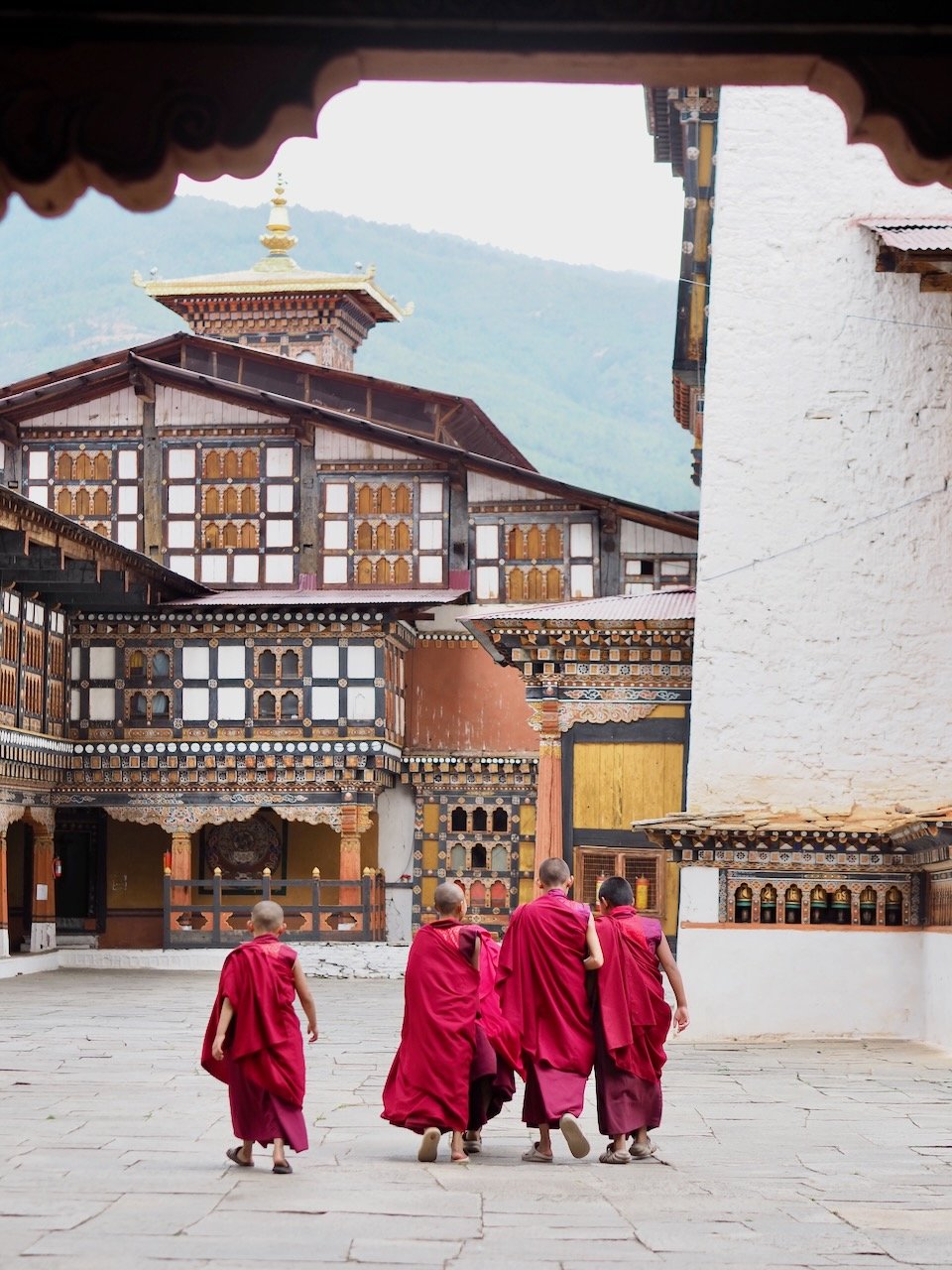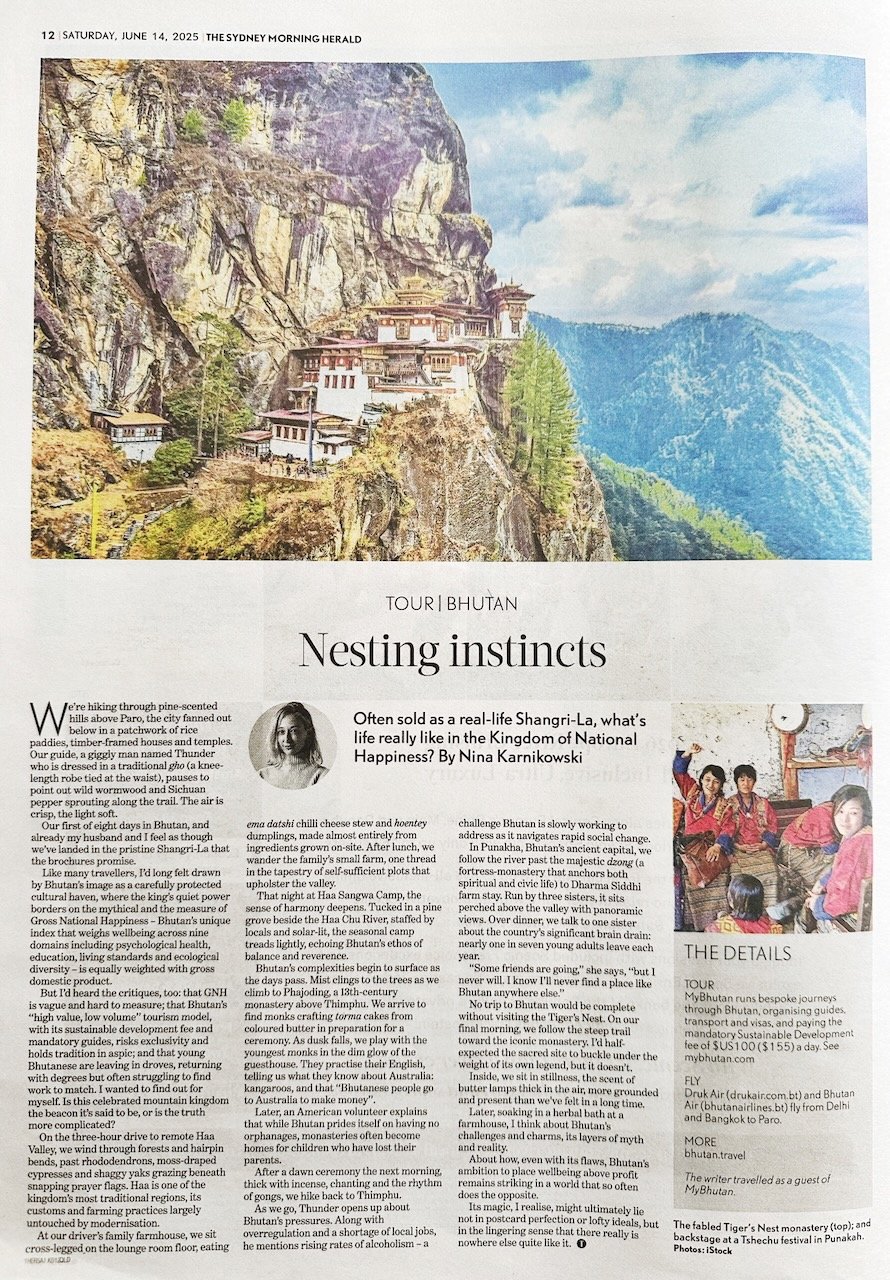BHUTAN, A REAL SHANGRI-LA?: SMH TRAVELLER
OFTEN SOLD AS A REAL-LIFE SHANGRI-LA, WHAT'S LIFE REALLY LIKE IN THE KINGDOM OF NATIONAL HAPPINESS? BY Nina karnikowskiWe’re hiking through pine-scented hills above Paro, the city fanned out below in a patchwork of rice paddies, timber-framed houses and temples. Our guide, a giggly man named Thunder dressed in a traditional gho (a knee-length robe tied at the waist), pauses to point out wild wormwood and Sichuan pepper sprouting along the trail. The air is crisp, the light soft.
Our first of eight days in Bhutan, and already my husband and I feel as though we’ve landed in the pristine Shangri-La the brochures promise.
Like many travellers, I’d long felt drawn by Bhutan’s image as a carefully protected cultural haven, where the king’s quiet power borders on the mythical and the measure of Gross National Happiness - Bhutan’s unique index that weighs wellbeing across nine domains including psychological health, education, living standards and ecological diversity - is equally weighted with gross domestic product.
But I’d heard the critiques, too: that GNH is vague and hard to measure; that Bhutan’s ‘high value, low volume’ tourism model, with its sustainable development fee and mandatory guides, risks exclusivity and holds tradition in aspic; and that young Bhutanese are leaving in droves, returning with degrees but often struggling to find work to match. I wanted to find out for myself. Is this celebrated mountain kingdom the beacon it’s said to be, or is the truth more complicated?
On the three-hour drive to remote Haa Valley, we wind through forests and hairpin bends, past rhododendrons, moss-draped cypresses and shaggy yaks grazing beneath snapping prayer flags. Haa is one of the kingdom’s most traditional regions, its customs and farming practices largely untouched by modernisation.
At our driver’s family farmhouse, we sit cross-legged on the lounge room floor, eating ema datshi chilli cheese stew and hoentey dumplings, made almost entirely from ingredients grown on-site. After lunch, we wander the family’s small farm, one thread in the tapestry of self-sufficient plots that upholster the valley.
That night at Haa Sangwa Camp, the sense of harmony deepens. Tucked in a pine grove beside the Haa Chu River, staffed by locals and solar-lit, the seasonal camp treads lightly, echoing Bhutan’s ethos of balance and reverence.
Bhutan’s complexities begin to surface as the days pass. Mist clings to the trees as we climb to Phajoding, a 13th-century monastery above Thimphu. We arrive to find monks crafting torma cakes from coloured butter in preparation for a ceremony. As dusk falls, we play with the youngest monks in the dim glow of the guesthouse. They practise their English, telling us what they know about Australia: kangaroos, and that “Bhutanese people go to Australia to make money.”
Later, an American volunteer explains that while Bhutan prides itself on having no orphanages, monasteries often become homes for children who have lost their parents.
After a dawn ceremony the next morning, thick with incense, chanting and the rhythm of gongs, we hike back to Thimphu.
As we go, Thunder opens up about Bhutan’s pressures. Along with overregulation and a shortage of local jobs, he mentions rising rates of alcoholism - now the country’s leading cause of hospital admissions - a challenge Bhutan is slowly working to address as it navigates rapid social change.
In Punakha, Bhutan’s ancient capital, we follow the river past the majestic dzong (a fortress-monastery that anchors both spiritual and civic life) to Dharma Siddhi farm stay. Run by three sisters, it sits perched above the valley with panoramic views. Over dinner, we talk to one sister about the country’s significant brain drain: nearly one in seven young adults leave each year.
“Some friends are going,” she says, “but I never will. I know I’ll never find a place like Bhutan anywhere else.”
No trip to Bhutan would be complete without visiting the Tiger’s Nest. On our final morning, we follow the steep trail toward the iconic monastery. I’d half-expected the sacred site to buckle under the weight of its own legend, but it doesn’t.
Inside, we sit in stillness, the scent of butter lamps thick in the air, more grounded and present than we’ve felt in a long time.
Later, soaking in a herbal bath at a farmhouse, I think about Bhutan’s challenges and charms, its layers of myth and reality.
About how, even with its flaws, Bhutan’s ambition to place well-being above profit remains striking in a world that so often does the opposite.
It’s magic, I realise, might ultimately lie not in postcard perfection or lofty ideals, but in the lingering sense that there really is nowhere else quite like it.

